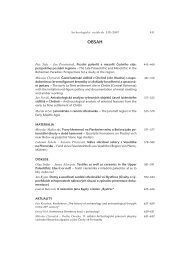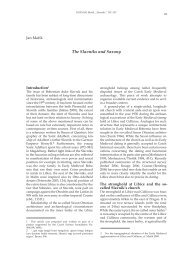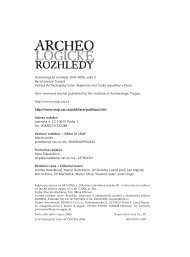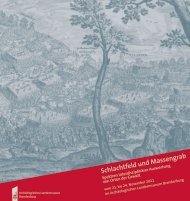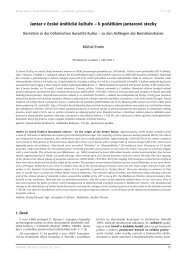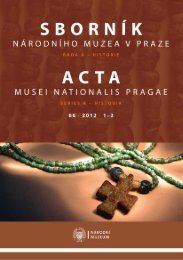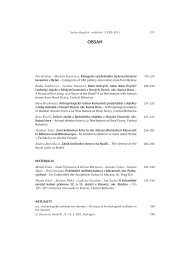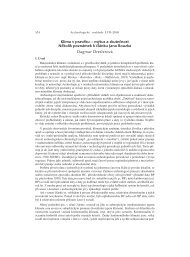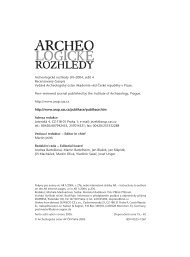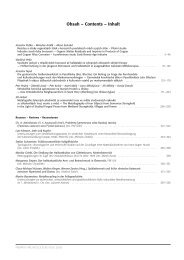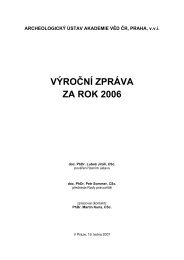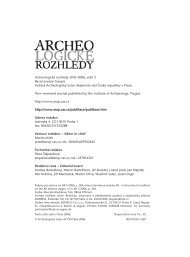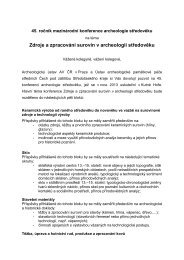96PRÒCHOVÁ –CHROUSTOVSK¯: Víceãetn˘ pohfieb ze star‰í doby bronzové …Hásek, I. – Pleinerová, I. 1978: Výpověď pohřebišť a pohřebního ritu. In: R. Pleiner – A. Rybová edd., Pravěkédějiny Čech, Praha: Academia, 367–372.Henderson, J. 1987: Factors determining the state of preservation of human remains. In: Boddington –Garland – Janaway eds. 1987, 43–54.Herrmann, B. – Grupe, G. – Hummel, S. – Piepenbrink, H. – Schutkowski, H. 1990: Prähistorische AnthropologieLeitfaden der Feld- und Labormethoden. Berlin: Springer.Chattah Lev-Tov, N. – Smith, P. 2006: Variation in occlusal dental wear of two chalcolithic populations inthe southern Levant, American Journal of Physical Anthropology 130, 471–479.Jelínková, Z. – Sláma, J. 1959: Hromadné pohřby únětické kultury v Tursku u Prahy, <strong>Archeologické</strong> <strong>rozhledy</strong>11, 323–334, 345–347.Jiráň, L. ed. 2008: Archeologie pravěkých Čech 5. Doba bronzová. Praha: <strong>Archeologický</strong> <strong>ústav</strong> <strong>AV</strong> <strong>ČR</strong>.Knüsel, C. J. – Janaway, R. C. – King, S. E. 1996: Death, decay, and reconstruction: archaeological evidenceof cadaveric spasm, Oxford Journal of Archaeology 15, 121–128.Kovářík, J. 1983: Sídliště únětické kultury v Praze 9 – Čakovicích, Archaeologica Pragensia 4, 137–168.Kruťová, M. – Turek, J. 2004: Some spatial aspects of the ritual behavioural at the beginning of Bronze Age.In: L. Šmejda – J. Turek eds., Spatial Analysis of Funerary Areas, Plzeň: Katedra archeologie FF ZČU,48–56.Lovejoy, C. O. 1985: Dental wear in the Libben population. Its functional pattern and role in the determinationof adult skeletal age at death, American Journal of Physical Anthropology 68, 47–56.Lutovský, M. – Sklenář, K. edd. 1993: Vepřek. <strong>Archeologický</strong> výzkum na Kralupsku. Praha – Kralupy nadVltavou: Národní muzeum – Městské muzeum Kralupy nad Vltavou.Lyman, R. L. 1994: Vertebrate Taphonomy. Cambridge Manuals in Archaeology. Cambridge: CambridgeUniversity Press.Maresh, M. M. 1970: Measurements from roentgenograms. In: R. W. Mc Cammon ed., Human Growth andDevelopment, Springfield IL.: C.C. Thomas, 157–200 (cit. dle L. Scheuer – S. Black: DevelopmentalJuvenile Osteology. New York: Academic Press 2000).Matoušek, V. 1982: Pohřební ritus rané únětické kultury v Čechách. In: Praehistorica 10. Varia archaeologica 3,Praha: Univerzita Karlova, 33–53.Moucha, V. 1954: Rozbor únětického pohřebiště v Polepech u Kolína, <strong>Archeologické</strong> <strong>rozhledy</strong> 6, 502–503,523–536, 566–567, 573–575.Neustupný, E. 1986: Nástin archeologické metody, <strong>Archeologické</strong> <strong>rozhledy</strong> 38, 525–549.— 1995: The significance of facts, Journal of European Archaeology 3, 189–212.— 1998: Otherness in prehistoric times. In: L. Larsson ed., The World View of Prehistoric Man, Lund:The University, 65–71.— 2007a: Metoda archeologie. Plzeň: Katedra archeologie FF ZČU.— 2007b: Vymezení archeologie. In: M. Kuna ed., Pravěký svět a jeho poznání. Archeologie pravěkýchČech 1, Praha: <strong>Archeologický</strong> <strong>ústav</strong> <strong>AV</strong> <strong>ČR</strong>, 11–22.Ondráček, J. 1962: Únětické pohřebiště u Rebešovic na Moravě. In: Sborník Československé společnostiarcheologické 2, Praha, 5–100.Peška, J. 2005: Protoúnětické pohřebiště z Pavlova, Pravěk NŘ 15, 83–118.Pleinerová, I. 1960: Únětické pohřebiště a osada v Blšanech u Loun, Památky archeologické 51, 488–526.Průchová, E. 2006: Tafonomie kosterních pozůstatků dospělých jedinců z pohřebiště u kostela sv. Ducha(Všeruby). Nepubl. diplom. práce, Plzeň: Katedra antropologie FF ZČU.Průchová, E. – Chrámecký, M. 2008: Antropologická zpráva o kosterních nálezech. In: Daněček 2008a.Salaš, M. 1990: Únětická sídlištní jáma s lidskými kosterními pozůstatky na Cezavách u Blučiny, Památkyarcheologické 81, 275–307.Schiffer, M. B. 1996: Formation Processes of the Archaeological Record. Salt Lake City: University of Utah Press.Sjøvold, T. 1990: Estimation of stature from long bones utilizing the line of organic correlation, HumanEvolution 5, 431–447.Sládek, V. – Kavánová, B. 2003: Statistické hodnocení tafonomických, ostearcheologických a antropologickýchparametrů pohřebiště u 12. kostela v Mikulčicích. In: N. Profantová – B. Kavánová edd., Mikulčice– pohřebiště u 6. a 12. kostela. Spisy <strong>Archeologické</strong>ho <strong>ústav</strong>u <strong>AV</strong> <strong>ČR</strong> 22, Brno: <strong>Archeologický</strong> <strong>ústav</strong><strong>AV</strong> <strong>ČR</strong>, 435–460.Smejtek, L. – Vojtěchovská, I. 1997: Velké Přílepy 1994–1995: předběžné výsledky a strategie výzkumu zanikajícílokality, <strong>Archeologické</strong> <strong>rozhledy</strong> 49, 9–18.
<strong>Archeologické</strong> <strong>rozhledy</strong> LXI–<strong>2009</strong> 97Sorg, M. H. – Haglund, W. D. 2002: Advancing forensic taphonomy: purpose, theory, and practice. In:W. D. Haglund – M. H. Sorg eds., Advances in Forensic Taphonomy. Method, Theory and ArchaeologicalPerspectives, Boca Raton: CRC Press LLC, 3–29.Sosna, D. 2007a: Social Differentiation in the Late Copper Age and the early Bronze Age in South Moravia(Czech Republic). Nepubl. disert. práce, Departement of Anthropology, The Florida State University.— 2007b: Sekundární pohřební aktivity: srovnávací studie. In: I. Budil – T. Zíková edd., Antropologickésymposium V. Sborník z V. antropologického symposia. Plzeň 30.6. a 1.7. 2006, Ústí n. Labem: VlastaKrálová a FF ZČU, 169–182.Stuchlík, S. – Stuchlíková, J. 1996: Pravěká pohřebiště v Moravské Nové Vsi – Hruškách. Studie ARÚ <strong>AV</strong> <strong>ČR</strong>v Brně 16.1. Brno: <strong>Archeologický</strong> <strong>ústav</strong> <strong>AV</strong> <strong>ČR</strong>.Světlík, I. 2008: Výsledky radiouhlíkového datování vzorku kostí z lokality Velké Přílepy, č. vz. 72053, 7202,7204. Ms., Praha: CRL – Radiouhlíková laboratoř, Ústav jaderné fyziky a <strong>Archeologický</strong> <strong>ústav</strong> <strong>AV</strong> <strong>ČR</strong>.Tihelka, K. 1953: Moravská únětická pohřebiště, Památky archeologické 44, 229–328.Ubelaker, D. H. 1989: Human Skeletal Remains. Second Edition. Washington D.C.: Taraxacum Press.Vařeka, P. 2003: Archeologie pravěkých jam. Typologie zahloubených objektů na sídlišti knovízské kulturyvPraze – Hostivaři. In: L. Šmejda – P. Vařeka edd., Sedmdesát neustupných let, Plzeň: Katedra archeologieFF ZČU, 219–256.Velemínský, P. 1999: Morfologické znaky na lidské kostře. In: M. Stloukal et al., Antropologie. Příručka prostudium kostry, Praha: Národní muzeum, 112–167.White, T. D. 2000: Human Osteology. Second Edition. New York: Academic Press.Sépulture multiple de l’Age de bronze ancien à Velké Přílepy(Bohême centrale)Contribution à l’étude de la taphonomie,de l’origine et de la raison d’un complexe funéraire1. Introduction et objectifsNotre objectif consiste en l’étude d’un contexte funéraire intéressant pour l’étude des sujets etquestions théoriques et méthodiques, qui ont trait aux populations du passé (intentionnalité, mode decréation et but du contexte funéraire) et ses transformations en source archéologique (transformationde forme et qualité de position des restes osseux). L’objet de notre étude consiste en l’étude d’unesépulture multiple de 6 individus datée au 14 C; une méthode utilisée pour l’Age de bronze ancien,qui a été découverte lors des fouilles archéologiques effectuées à Velké Přílepy (passé district Prague– Ouest) en mai 2007 (Daněček 2008a).2. Conception théorique et questions2.1. Le caractère d’intentionnalité des activités funérairesLa première sphère générale à nos questions théoriques est une intentionnalité, qui est alliée avecl’enterrement. Ce qui nous intéresse avant tout est de savoir qui étaient les défunts, s’ils existaient desrapports biologiques ou sociaux entre eux. Ensuite, ce qui nous intéresse sont les circonstances quiont mené à la sépulture multiple de 6 individus, la cause de leur mort et surtout l’objectif de ceux quiles ont enterré.La théorie archéologique distingue deux concepts fondamentaux quant aux objectifs. Le conceptexpressif se rapporte à une expression de l’ordinaire, de la convenance, de l’appartenance au mondedes autres (Neustupný 1998). Le concept instrumental implique une fonction pratique (l’aptitude deservir en tant qu’agent d’interaction avec un environnement matériel), une acception sociale (l’aptitudede servir en tant qu’agent d’interaction avec un environnement social) et un sens symbolique(l’aptitude de servir en tant qu’agent de la communication ; Neustupný 1995 ; 2007b). Le but quenous étudions ici est établi en fonction de la sépulture en complexe fonctionnel – un complexe dontla dimension des sources empiriques correspond au complexe découvert (voir Neustupný 2007a, 35).



